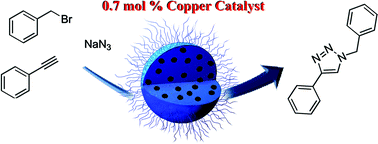Magnetic nanoparticles entrapped in the cross-linked poly(imidazole/imidazolium) immobilized Cu(ii): an effective heterogeneous copper catalyst†
Abstract
Anchoring of copper sulfate in layered poly(imidazole-imidazolium) coated magnetic nanoparticles provided a highly stable, active, reusable, high loading, and green catalyst for the click synthesis of 1,2,3-triazoles via a one-pot cycloaddition of alkyl halide, azide, and alkyne (Cu-A3C). The catalyst was characterized by FTIR, TGA, TEM, SEM, XRD, EDAX, VSM and AAS. High selectivity, broad diversity of alkyl/benzyl bromide/chloride and alkyl/aryl terminal alkynes, and good to excellent yields of products were obtained using 0.7 mol% catalyst. The catalyst was readily recovered and reused up to 6 times without significant loss of activity.


 Please wait while we load your content...
Please wait while we load your content...